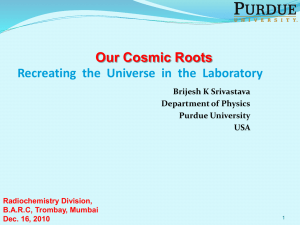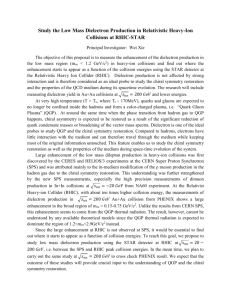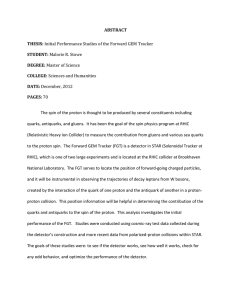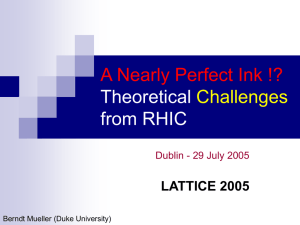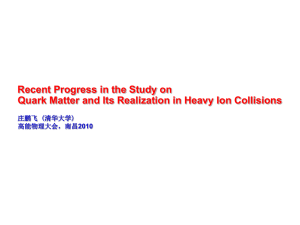200 GeV Au+Au Collisions, RHIC at BNL Animation by Jeffery Mitchell
advertisement
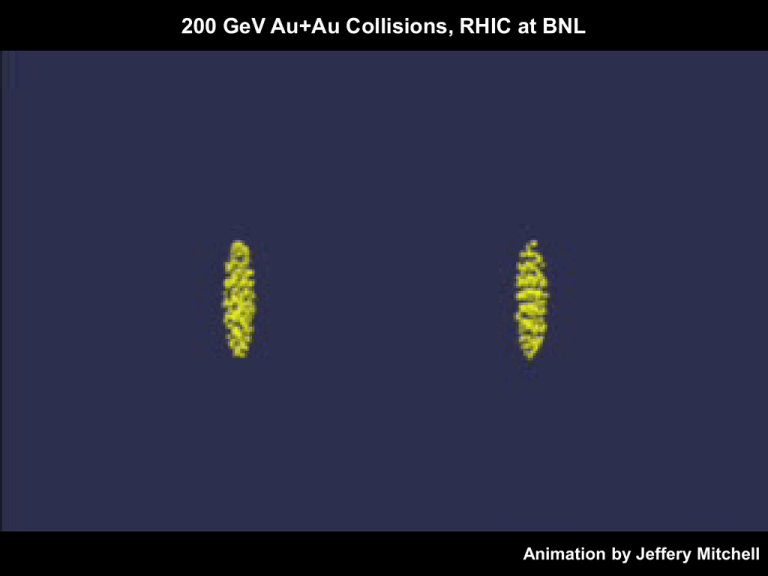
200 GeV Au+Au Collisions, RHIC at BNL Animation by Jeffery Mitchell Elephants in a Liquid A Closer Look at the Nucleus Atom Nucleus Atom: positive nucleus and negatively charged electron cloud Ion = Atom stripped of electrons Nucleus: nucleons = protons and neutrons Nucleon: partons = quarks and gluons Proton • arises from fundamental strong force • acts on color charge of quarks Interactions described by theory of QuantumChromo-Dynamics (QCD) Particles hadrons baryons mesons photons gluons protons, neutrons pions, kaons Bound states, no free quarks observed Confinement – Quarks are not “free” Confinement – Quarks are not “free” The Strong Nuclear Force • Strong nuclear force has some very unusual properties – doesn’t get weaker with increasing distance! • quarks, anti-quarks appear, break original connection into more and more and more particles Deconfinement Au+Au 197 + 197 nucleons Add=more nucleons Collide at High Energy Add pions Deconfinement Quark Gluon Plasma The Early Universe Try to create QGP in Lab • Take heavy ions – Au ( at RHIC) – big atoms, many protons, gluons and quarks • Accelerate ions to increase their energy • Smash them together ( let them collide) • Hope to create QGP RHIC Physics Program Why collide Heavy Ions? • RHIC was proposed in 1983 • One of the main emphases is study of properties of matter under extreme conditions – large energy densities – high temperatures To achieve these conditions we collide heavy nuclei at very high energies Why? • To help us understand the basic building blocks of matter and their interactions • To help us understand the early composition of our universe and its formation Relativistic Heavy Ion Collider Relativistic Einstein’s relativity E=mc2, near light speed Heavy Ion Elements like gold,without electrons Collider Two ion beams hit head-on as seen by the Landsat-4 satellite… RHIC from Space Inside the RHIC Ring • Underground tunnel • Super-conducting magnets cooled by liquid helium (@ 4.5 K) • 1740 Magnets • 2.4 Mile circumference STAR Each EachCollaboration collaboration~ 50 physicists about 400 physicists and engineers PHENIX 200 GeV Au+Au Collisions in the PHENIX detector Animation by Jeffery Mitchell Example of Au+Au collisions in collider (STAR event display) Experimentalist at work …. …. as opposed to a theorist working Not all collisions look the same peripheral collision QGP ??? central collision NO YES ? QGP ??? Not all collisions look the same Not all collisions look the same Just More ? Just x 1000 ? Number of particles Proton-proton collision 1= QGP ??? Number of events Number of particles NO Number of events x central collision QGP ??? - Collision At One Trillion Degrees, Even Gold Turns Into the Sloshiest Liquid Source: New York Times Published: 4/19/2005 Scientists Report Hottest, Densest Matter Written by: Chang, Kenneth Ever Observed It is about a trillion degrees hot and flows like water. Actually, it flows much better than water. Scientists at the Brookhaven National Laboratory on Long Island announced yesterday that experiments at its Relativistic Heavy Ion Collider - RHIC, for short, and pronounced "rick" - had produced a state of matter that is unexpectedly sloshy. "Every substance known to mankind before would evaporate and become a gas at two million, three million degrees," said Dr. Dmitri Kharzeev, a theoretical physicist at Brookhaven. "So the big surprise here is the matter created at RHIC is a liquid." Gas vs. Liquid How to Probe the Matter that is Produced? Ideal Experiment: vacuum penetrating beam QGP absorption or scattering pattern But QGP only exists ~ 10-23 seconds How can we probe a state that exists for such a short time? Quarks in QGP The Charm Standard Model (Prof. Fries’ lecture) 6 fermions and 6 leptons come in 3 identical generations (only masses are different) Plus they have antiparticles. Leptons and quarks feel the weak force. Only quarks have color charges and feel the strong force. Nobel Prize - 1976 • Discovery of the J/psi Particle (“charmonium”) • The 1976 Nobel Prize in physics was shared by a Massachusetts Institute of Technology researcher, Samuel C.C. Ting (right), who used Brookhaven's Alternating Gradient Synchrotron (AGS) to discover a new particle and confirm the existence of the charmed quark. c c What do we expect from J/Y in QGP? In a hot QCD medium, when the temperature is raised well beyond the deconfinement temperature, the J/ψ and its excitations are expected to melt. We expect a suppression of bound states due to color screening in the Quark Gluon Plasma. (Matsui and Satz, 1986) c c Color Screening Data from SPS Deconfinement via J/Y Suppression at RHIC • Lattice calculations predict J/Y survives in plasma up to ~2 Tc • Suppression at RHIC should be larger than SPS because of larger energy density • Charm cross-section larger at RHIC than SPS – ~ 20 cc pairs produced per collision • We have evidence that charm may be partially thermalized at RHIC Could we have recombination of cc pairs to regenerate J/Y ? J/Y – Data Comparison to Theory Models Models thatimplementing were successful suppression in describing and regeneration: SPS data fail to describe reasonable data at RHIC agreement - too much with the suppression data Summary • Goal at RHIC is to create Quark-Gluon Plasma (deconfinement of quarks) • RHIC has collided Au+Au, p+p, and d+Au • There are 4 RHIC experiments (2 large, 2 small) • Results imply that we have created a very dense medium in Au+Au collisions • Wealth of data – only one physics topic shown today – J/Y data consistent with melting and regenerating in plasma
